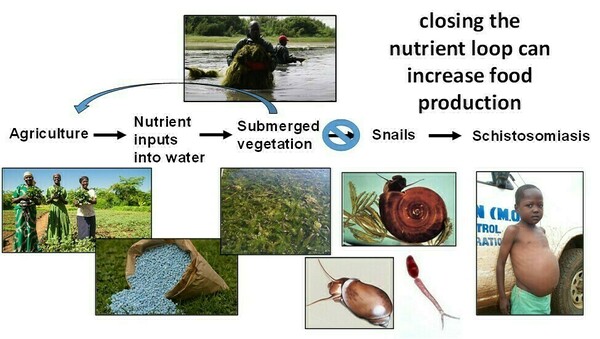Energy, Sustainability, and Climate Change
Because aquatic plant (Ceratophyllum demersum) overgrowth appears to be at least partially caused by runoff from agriculture, we hypothesized that we could profitably improve food production and sustainability by returning the nutrients captured in the removed plants back to agriculture, thus reducing nitrogen and phosphorus pollution by partly closing the nutrient loop (Fig. 1). Hence, this would turn a public nuisance (i.e., invasive vegetation) into a private good, which might promote greater intervention adoption.
 Fig. 1. Hypothesis that we could profitably improve food production and sustainability by returning the nutrients captured in the removed plants back to agriculture, thus reducing nitrogen and phosphorus pollution by partly closing the nutrient loop.
Fig. 1. Hypothesis that we could profitably improve food production and sustainability by returning the nutrients captured in the removed plants back to agriculture, thus reducing nitrogen and phosphorus pollution by partly closing the nutrient loop.
To test this hypothesis, we collaborated with local communities to evaluate whether the removed aquatic vegetation could be cost-effectively (i) converted to compost to increase crop yields, (ii) used as livestock feed (see Food, Sustainability, and Climate Change tab), or (iii) used as fuel in biodigesters that use anaerobic bacteria, namely methanogens, to produce both fertilizer and gas that can be used for cooking or in generators that produce electricity.
We are particularly excited about co-digesting Ceratophyllum demersum and animal manure in biodigesters because the Swiss government has invested in 60,000 biodigesters in Senegal, but only currently have ~2,000 installed. Given that 87% of households in Senegal use firewood and charcoal as cooking fuel and that methane, the predominant gas released from animal manure, accounts for ~16% of global greenhouse gas emissions and is 80 times as potent at warming the planet as carbon dioxide, biodigesters should reduce deforestation and mitigate against climate change. In fact, the Swiss government has invested in biodigesters in Senegal to receive carbon credits. The primary fuel currently being used in these biodigesters are cow patties. However, the more biodigesters that are installed the more limiting cow patties will become.
 Fig. 2. The use of gas from biodigesters for cooking in Africa.
Fig. 2. The use of gas from biodigesters for cooking in Africa.
Our mesocosm trials in the lab testing a gradient of C. demersum co-digestion quantities with cow manure indicate that the addition of C. demersum improves gas quality and flame burn time and intensity (in preparation). In collaboration with the Programme National de Biogaz Sénégal, similar patterns were observed using biodigesters installed in Senegal (in preparation). Hence, co-digesting C. demersum with animal manure seems to improve energy production for households and offers a fertilizer amendment for their crops, while having the co-benefits of diminishing deforestation, mitigating climate change, and reducing human schistosomiasis.